The wreck of the Montebello on Kangaroo Island is well-documented in books such as “Kangaroo Island Shipwrecks” by Gifford Chapman and “Shipwreck Sites of Kangaroo Island” by Robert McKinnon. Not so well-documented is the Underwater Explorers Club of South Australia’s visit to the site around 1967.
It just so happened that during the UEC’s second year of existence (1956), a future President for the group was the ‘curator’ of the Kelly Hill Caves on Kangaroo Island. The caves are close to the wreck site of the Montebello.
It would be some years before George D (Doug) Seton would “get into diving” but, as ‘curator’ of the Kelly Hill Caves, Doug got to meet Percy May, one of the KI locals. Percy had been awarded a gold medal, along with a pair of binoculars, from the French Government in recognition of his involvement in the wreck of the Montebello in 1906.
Percy was just 21 years old when the Montebello was wrecked at Stunsail Boom near Vivonne Bay on the south coast of KI. His story was related in 20th December 1956 edition of The Advertiser (“Out Among the People” by Vox). It seems that Percy visited Doug at the Kelly Hill Caves that same year. Doug kept a copy of the newspaper article about Percy. He sent a copy to me, along with a 1967 newspaper report of the UEC’s visit to the wreck site.
Within 9 years of meeting Percy, Doug had started diving and had been elected as Treasurer of the UEC in 1965. He became President two years later, followed by three years more as Vice-President and another year as Committee Person.
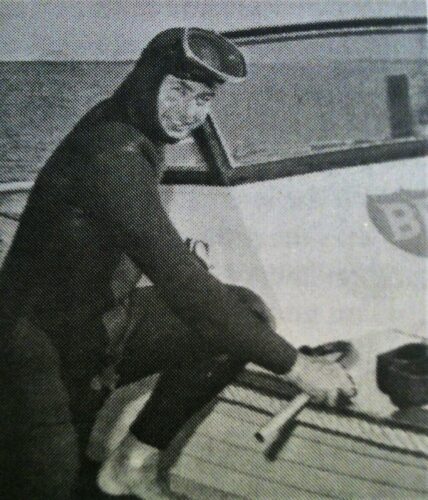
Doug Seton
(As featured in “Let’s Go for a Dive – 50 years of the Underwater Explorers Club of SA”, 2004)
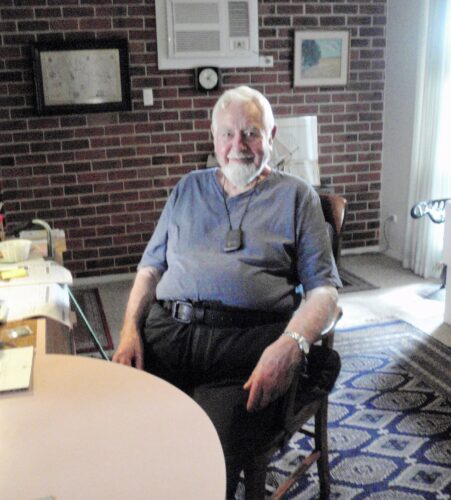
Doug Seton in 2019
As President in 1967, Doug returned to KI to attempt a dive on the Montebello wreck site, along with Ray Sedunary, John Garfield and local diver Vic Clark. One-time Patron for the UEC, long-term committee member and Honorary Life Member, Dave Burchell had made an earlier trip to the site, but had been unable to dive in the rough conditions there.
I found some details in Dave Burchell’s book “One Foot in the Grave”. Dave mentions a trip to Stun Sail Boom (Stun’Sail, Stunsail, or Stun-sail Boom) River* with Bob Main, Dudley Farquhar, John Rathbone, Doug Seton and local Don Dixon.
* (The river was named after the boom of studding sail located on the outside of the square rigging of a sailing ship. Sailors used the slang term ‘stuns’l’. The river was so-named after a stun’sail boom was found at its mouth by Robert Fisher and others on 7 November 1836.)
Doug Seton made another trip in November (1966?) with David Condon. Doug returned again on Boxing Day (Tuesday 26th December 1967?) with Ray Sedunary, John Garfield and Vic Clark. They had to drive down a rough track to get to the wreck site. They then had to scramble over rocks whilst carrying scuba and other gear.
This team had a bit better luck with the conditions than Dave Burchell had years earlier. Although Dave’s team had gathered a few artefacts from the shallows during their trip, Doug’s team also found many artefacts there.
The team found a huge crevice, which turned out to be the Montebello’s final resting site. The ship had miraculously sailed right into the crevice, and close to shore. This would turn out to be the saving grace for the crew who all survived.
According to Robert McKinnon in “Shipwreck Sites of Kangaroo Island”, the Montebello “established (the first) notable record in that it was the first recorded vessel that went ashore on the south-west coast of Kangaroo Island without losing a single human life”.
Doug’s team were able to dive at the wreck site a second time when they returned on Wednesday (27th December 1967?), this time with local diver Roy Tipping in place of John Garfield. This second time they went with large, compressed air cylinders which they used as ‘hookahs’ for their dives.
Everything that was recovered from the wreck site over the two dives was placed in local National Trust Museum.
Doug’s report in the 1967 newspaper included these maps: –
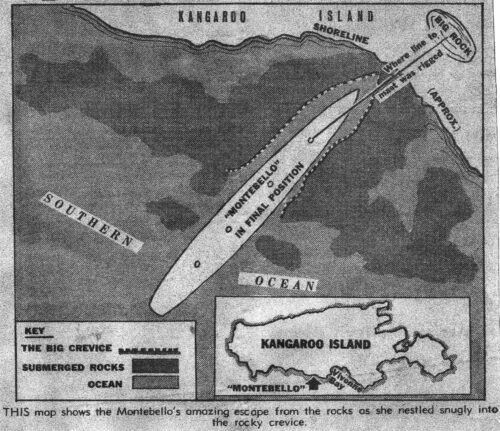
The article also included this photo of the Montebello’s crew, taken whilst they were in Adelaide: –
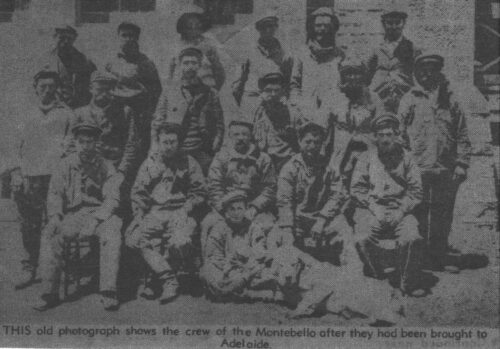
Doug says that the Adelaide Observer’s 24th November 1906 issue reported the wrecking of the Montebello. “Shipwreck Sites of Kangaroo Island” by Robert McKinnon states that KI diver John Lavers was holding several fittings from the Montebello. The Kingscote Museum was also holding some artefacts from the vessel.
John Lavers wrote in the December 1978 issue of “Skindiving in Australia” (Vol.8, No.7) about diving on the wreck of the Montebello, along with Colin Bolton. John described it as being “one of the most exciting dives” he had ever been on, and that is really saying something!
Wreckage was “strewn all around: brass portholes embedded in rocks, spars and two large anchors”. Copper hand-rails and brass fixtures were seen. The diving was hard work and tricky due to the prevailing conditions though.
Both “Kangaroo Island Shipwrecks” by Gifford Chapman and “Shipwreck Sites of Kangaroo Island” by Robert McKinnon feature relevant photographs of the wreck and associated items. “Kangaroo Island Shipwrecks” features a photo of the crew. Here are some photos from “Shipwreck Sites of Kangaroo Island”: –
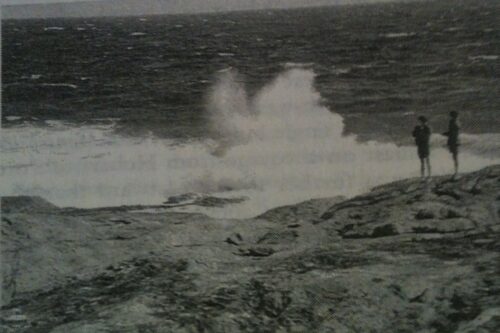
Location of the Montebello wreck site
(Taken by Bill Jeffery, as featured in “Shipwreck Sites of Kangaroo Island” by Robert McKinnon)
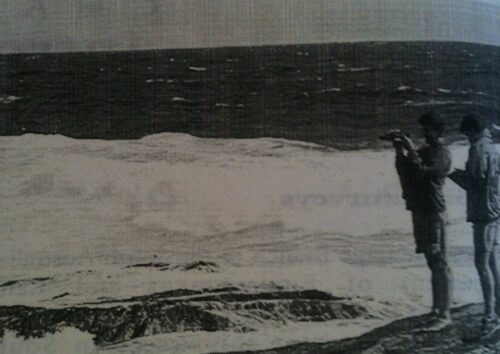
Obtaining a GPS fix onshore adjacent to the Montebello wreck site
(Taken by Bill Jeffery, as featured in “Shipwreck Sites of Kangaroo Island” by Robert McKinnon)
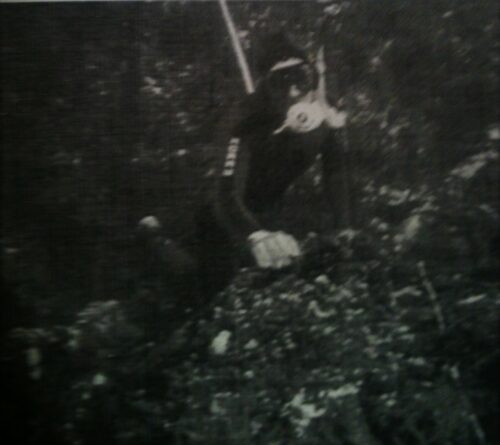
A diver on the Montebello wreck site
(Taken Robert McKinnon, as featured in his book “Shipwreck Sites of Kangaroo Island”)

Anchor on the Montebello wreck site in 1977
(Taken by Les Gray*, as featured in “Conserving Our Historic Shipwrecks”, SA Department of Environment & Planning, 1983)
* (Les Gray is listed as having been a UEC member at some stage.)
Percy May was born in 1885 and was still living at his birthplace, 60 Osborne Street, Kingscote in 1956, aged 71.
Doug was once an Information Officer for the SA Museum. He has had a 1100 acre property on KI. He still maintains contact with several of the Islanders. He led several shipwreck expeditions over the years, including recovering two of Matthew Flinders’ anchors from the Investigator and the bow anchor from the Margaret Brock. He also did much work with the Society for Underwater Historical Research.
(The header photograph was taken by Bill Jeffery, source “Shipwreck Sites of Kangaroo Island” by Robert McKinnon)
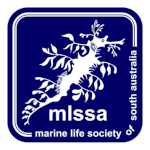

My interactions with Doug Seton were a bit back to front in time.
I first met him as a young kid when I would take moths butterflies and other insects (plus the occasional seedpod ,shell ,rock and so on) to the museum information officer’s desk.
During most of that phase of my childhood the late Hans Micham filled the role but I was helped on a number of occasions by Doug, and of course at the time I’d no idea how he came to be there (nor would I have cared. I just wanted to ask whoever was there what I had in my jars and boxes, and I remember how Doug would be quick to say if he couldn’t identify my specimens (he’d say that insects were not his strong point!) .But he would always run the specimens- sometimes with me and possibly my mother,or later me and one of my collector school friends or cousins etc in tow- out the back or up or down stairs – into the beating heart of the institution as it were-to ask any entomology types that happened to be available without notice.
Doug certainly did his utmost to get some sort of answer for we kids, and if he couldn’t get an answer on the day, we could leave a specimen with him knowing that he would return it in good condition with a good ID attached as a jotted note when we went back the following week.
Anyway, that was before I got into snorkeling and marine life generally.
Our paths rejoined, albeit only for a few short years, when I joined the UEC as an entry level diver at age 16.
He was a very active, enthusiastic club member, while I kept a low profile, focused on getting in on a the club’s free boat dives.
And now, finally, after reading this article (thanks again, Steve) I know the answer to a question that had always been on my mind but I had never asked anyone, including Doug,:- what did Doug Seton do before he landed that museum role and the later move into diving.
He was ‘manager ‘ of the Kelly Hill Caves!
Quite amazing!
Thanks David, we could catch up with Doug sometime soon perhaps?
Sounds like a good idea Steve (Caveat is my usual time manager and fwd planning limitations!?)